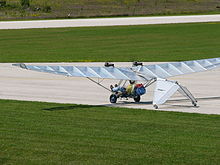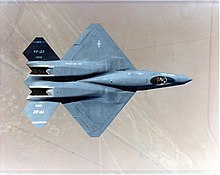
A T-tail is an empennage configuration in which the tailplane is mounted to the top of the fin. The arrangement looks like the capital letter T, hence the name. The T-tail differs from the standard configuration in which the tailplane is mounted to the fuselage at the base of the fin.

Aircraft flight control surfaces are aerodynamic devices allowing a pilot to adjust and control the aircraft's flight attitude.

A conventional fixed-wing aircraft flight control system (AFCS) consists of flight control surfaces, the respective cockpit controls, connecting linkages, and the necessary operating mechanisms to control an aircraft's direction in flight. Aircraft engine controls are also considered as flight controls as they change speed.

The Beechcraft Bonanza is an American general aviation aircraft introduced in 1947 by Beech Aircraft Corporation of Wichita, Kansas. The six-seater, single-engined aircraft is still being produced by Beechcraft and has been in continuous production longer than any other aircraft in history. More than 17,000 Bonanzas of all variants have been built, produced in both distinctive V-tail and conventional tail configurations; early conventional-tail versions were marketed as the Debonair.

The empennage, also known as the tail or tail assembly, is a structure at the rear of an aircraft that provides stability during flight, in a way similar to the feathers on an arrow. The term derives from the French language verb empenner which means "to feather an arrow". Most aircraft feature an empennage incorporating vertical and horizontal stabilising surfaces which stabilise the flight dynamics of yaw and pitch, as well as housing control surfaces.

A vertical stabilizer or tail fin is the static part of the vertical tail of an aircraft. The term is commonly applied to the assembly of both this fixed surface and one or more movable rudders hinged to it. Their role is to provide control, stability and trim in yaw. It is part of the aircraft empennage, specifically of its stabilizers.

An aircraft stabilizer is an aerodynamic surface, typically including one or more movable control surfaces, that provides longitudinal (pitch) and/or directional (yaw) stability and control. A stabilizer can feature a fixed or adjustable structure on which any movable control surfaces are hinged, or it can itself be a fully movable surface such as a stabilator. Depending on the context, "stabilizer" may sometimes describe only the front part of the overall surface.

The Aeronca Chief is a single-engine, light aircraft with fixed conventional landing gear and two seats in side-by-side configuration, which entered production in the United States in 1945.

An aircraft in flight is free to rotate in three dimensions: yaw, nose left or right about an axis running up and down; pitch, nose up or down about an axis running from wing to wing; and roll, rotation about an axis running from nose to tail. The axes are alternatively designated as vertical, lateral, and longitudinal respectively. These axes move with the vehicle and rotate relative to the Earth along with the craft. These definitions were analogously applied to spacecraft when the first crewed spacecraft were designed in the late 1950s.
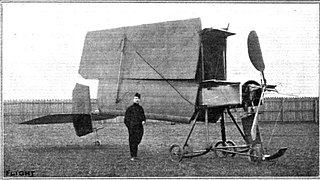
The Bréguet Type III was an early biplane built by Louis Bréguet in France in 1910.

The Pelikan tail is an experimental tail design for fighter jets. It was originally conceived by Ralph Pelikan, who was hired by McDonnell Aircraft, later worked for McDonnell Douglas after the merger of McDonnell with Douglas and, after another merger, retired from Boeing. The concept was used in the Northrop YF-23 fighter. However, it has been considered or included in design specifications in the McDonnell Douglas BAE Joint Strike fighter (JSF) design which was eliminated before prototype stage

In aeronautics, a tailless aircraft is an aircraft with no other horizontal aerodynamic surface besides its main wing. It may still have a fuselage, vertical tail fin, and/or vertical rudder.

The UltraFlight Lazair is a family of Canadian designed and built twin-engine ultralight aircraft that were sold in kit form between 1979 and 1984.

The Beechcraft Model 34 "Twin-Quad" was a prototype airliner designed and built by Beechcraft in the period between World War II and the Korean War. At this time many aircraft manufacturers in the United States anticipated a boom in civil aviation and a large number of designs left the drawing board only to ultimately fail. The Model 34 was one of these failures, partly because of its unusual design, and partly because of the thousands of ex-military transport aircraft that were available at the time for a fraction of the price of a new aircraft.
Supermaneuverability is the capability of fighter aircraft to execute tactical maneuvers that are not possible with purely aerodynamic techniques. Such maneuvers can involve controlled side-slipping or angles of attack beyond maximum lift.

The Nieuport II was a mid-wing monoplane racing or sport aircraft built by the Société Anonyme des Établissements Nieuport between 1910 and 1914 and was noted for its high performance using a small twin-cylinder engine, and winning many races, primarily in France before being used as a trainer during World War I by French flying schools.

The Hanriot 1909 monoplane was an early French aircraft constructed by Rene Hanriot, a successful automobile racer.
The Koolhoven F.K.44 was a two-seat, single engine sport monoplane designed and built in the Netherlands in the early 1930s. It was built to order, but only one was completed.
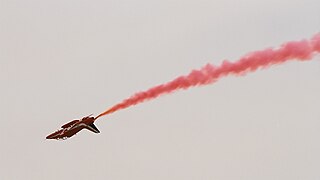
A slow roll is a roll made by an airplane, in which the plane makes a complete rotation around its roll axis while keeping the aircraft flying a straight and level flightpath. A slow roll is performed more slowly than an aileron roll; although it is not necessarily performed very slowly, it is performed slowly enough to allow the pilot to maintain balance, keeping a steady flightpath, pitch angle, and height (altitude) throughout the maneuver. The maneuver is performed by rolling the airplane at a controlled rate with the ailerons, and moving the elevators and rudder in opposition, or "cross-controlling," to keep the plane on a steady, level flightpath.
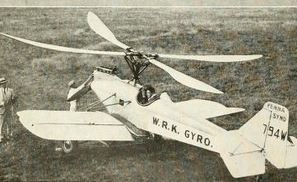
The Wilford Gyroplane was based on a German autogyro first flown in 1926. After E. Burke Wilford bought the rights and patents, it was developed in the US until 1936.


